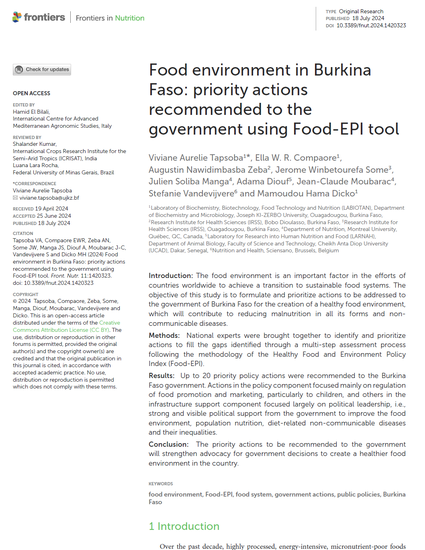
Article
Food environment in Burkina Faso: priority actions recommended to the government using Food-EPI tool
Frontiers in Nutrition
(2024)
Abstract
Introduction: The food environment is an important factor in the efforts of
countries worldwide to achieve a transition to sustainable food systems. The
objective of this study is to formulate and prioritize actions to be addressed to
the government of Burkina Faso for the creation of a healthy food environment,
which will contribute to reducing malnutrition in all its forms and non-
communicable diseases.
Methods: National experts were brought together to identify and prioritize
actions to fill the gaps identified through a multi-step assessment process
following the methodology of the Healthy Food and Environment Policy
Index (Food-EPI).
Results: Up to 20 priority policy actions were recommended to the Burkina
Faso government. Actions in the policy component focusedmainly on regulation
of food promotion and marketing, particularly to children, and others in the
infrastructure support component focused largely on political leadership, i.e.,
strong and visible political support from the government to improve the food
environment, population nutrition, diet-related non-communicable diseases
and their inequalities.
Conclusion: The priority actions to be recommended to the government
will strengthen advocacy for government decisions to create a healthier food
environment in the country.
Keywords
- food environment,
- Food-EPI,
- food system,
- government actions,
- public policies,
- Burkina Faso
Disciplines
Publication Date
Fall July 20, 2024
DOI
10.3389/fnut.2024.1420323
Citation Information
Viviane A. Tapsoba, Ella W. R. COMPAORE, Augustin N. ZEBA, Jerome W. SOME, et al.. "Food environment in Burkina Faso: priority actions recommended to the government using Food-EPI tool" Frontiers in Nutrition Vol. 11 (2024) p. 1 - 11 Available at: http://works.bepress.com/dicko/187/
Creative Commons license

This work is licensed under a Creative Commons CC_BY-SA International License.
